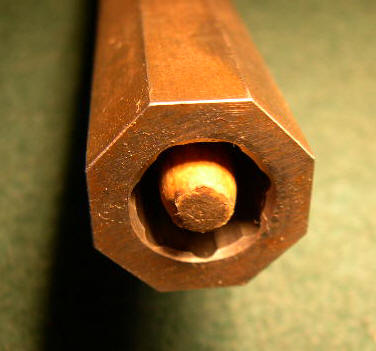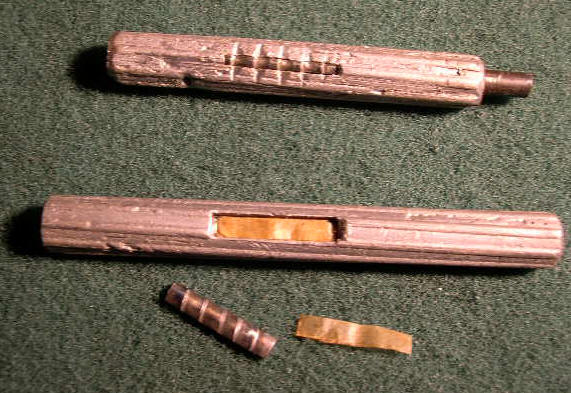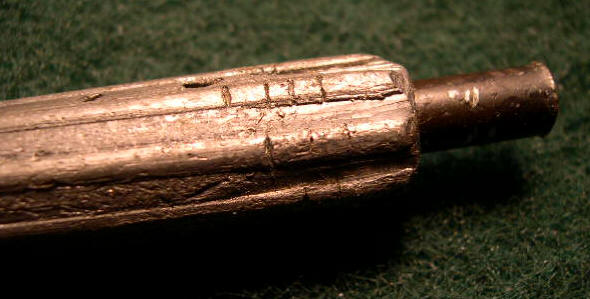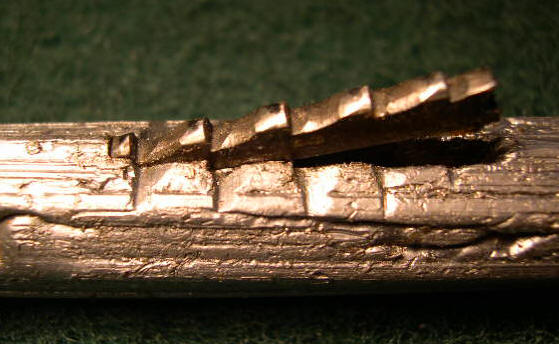| Freshening a
rifle barrel is a method for completely renewing the
rifle bore without reaming it smooth and re-rifling it.
The tools needed are easily made in the shop and,
although labor intensive, the work process is easily
mastered. Many period accounts refer to freshening a
barrel and, although nearly impossible to date, slugs
like the two described here survive.
Start by casting a lead slug around either a wood or
metal rod. I have used both pure lead and wheel weight
metal and don't see much difference. For a .50 Cal. the
rod can be 1/4 or 5/16 and I notch it so the slug will
grip. (That may not be necessary when cutting a new
barrel but when I used to fresh originals I'd often end
up pounding the slug through the barrel.) Just put a
cloth patch on the rod and center it in the muzzle.
Finished slug should be 5-6 inches long.


I cut the groves first then make a new slug for the
lands but if you are removing only 5 thousands or so you
could easily just inlet the lands saw in another part of
the same slug. Old barrels were sometimes so rough we
took out 3 or 4 calibers and then you definitely need a
new slug for the lands.

The teeth of both cutters are sharpened more like
scrapers than file or saw teeth. In other words the
front face is more or less 90 degrees. The teeth are
deliberately spaced unevenly to prevent chatter. I stone
the actual cutting edge real smooth. You don't want a
chip fusing to the edge and gouging the barrel.
I use the real thin paper that comes in new shirts as
shim material. It has more body than cigarette paper
which some recommend. Start by getting the slug moving
smoothly with no cutter. Inlet the cutter so it is just
below grade. The inletting deforms the slug so you will
need to get it working through the barrel again. Scrape
or file the high spots.

Always cut from breech to muzzle. You won't be able to
see the groves at the breech so make a mark on the
barrel face for lining up with a grove. You may be able
to see little numbers on the front end of the slug in
one picture. I cut grove 1, 2, 3 etc. go around until it
almost stops pulling chips and then shim. Start the new
shim in a different grove because it will cut the most
on the first pass--before it compresses. Using that
thickness of shim I usually go all the way around 3 or 4
times before shimming again. Both cutter in the pictures
have a notch at the front so they can be prized out of
the slug.


I place a dish or box with a cloth pad at the muzzle end
so when the slug drops out of the barrel in has a very
short fall. Don't want to jar the cutter out and lose
any shims. Clean chips and oil heavily. Job will take
better part of a day to re-cut a new barrel and two or
three days for a rusted out old one.

Forgot to mention two things about the lands saw. It can
be wider than the lands because the outside edges are
not touching anything. The lands saw is a slightly
quicker radius then the bore so it starts cutting only
in the center of the lands. When you finish the bore
will be like some 19th century rifles and all the tool
marks will be parallel to the rifling so there is less
patch cutting. The hollowed
lands were specified for contract rifles about 1808-1810
but I suspect they go back much farther.

(top) |